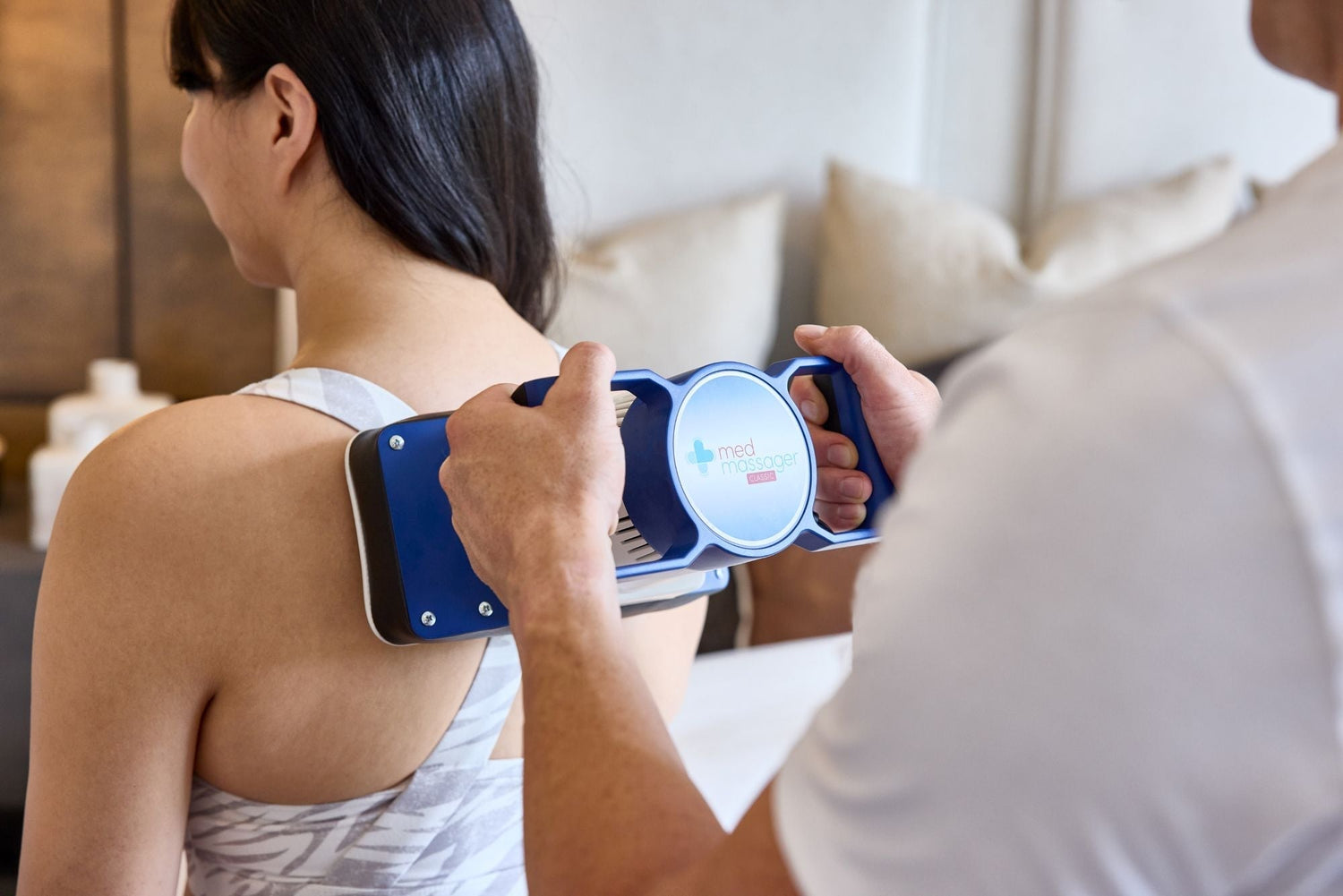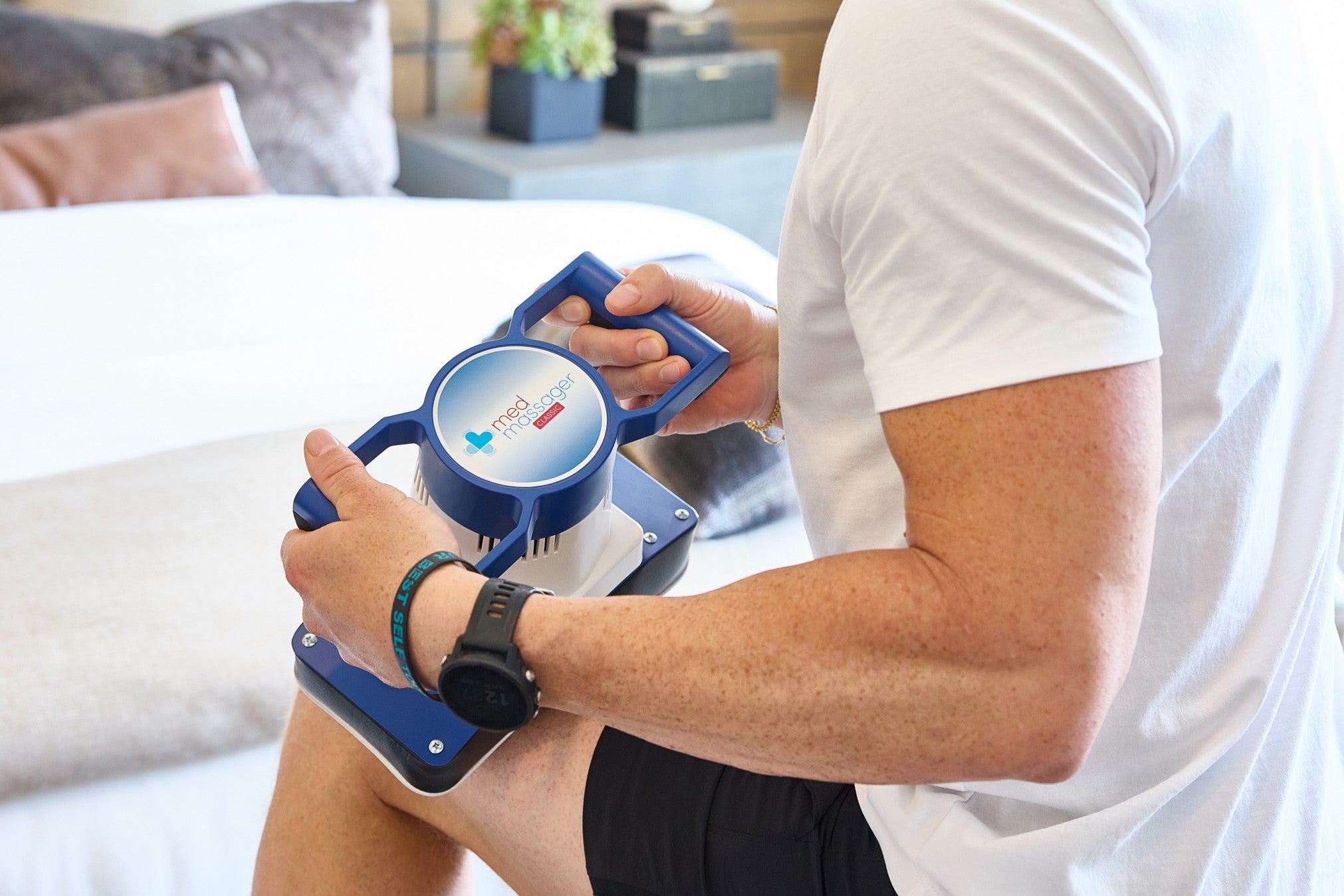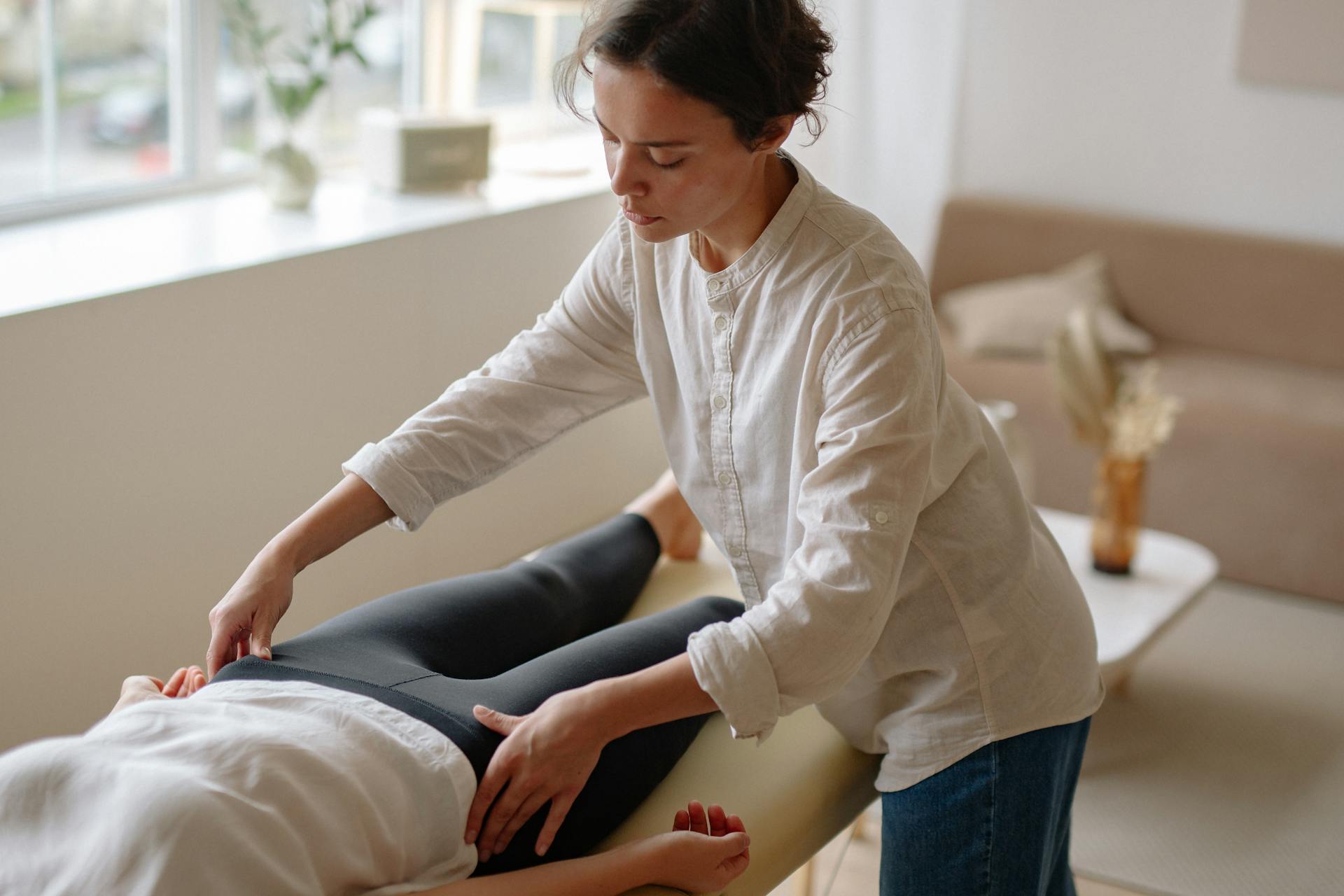Hoy en día, los seres humanos pasamos más tiempo sentados que nunca: una encuesta revela que uno de cada cuatro estadounidenses pasa sentado más de ocho horas al día. Y ya sea trabajando en un escritorio o viendo tu serie favorita, esto puede significar pasar mucho tiempo con la columna vertebral curvada hacia adelante.
A largo plazo, esta postura puede provocar problemas como el cuello curvo y hombros encorvados, lo que tensa los músculos y altera la mecánica corporal. Por suerte, si buscas combatir la postura encorvada de la parte superior del cuerpo, o la tensión que conlleva, la terapia de masajes podría ayudarte.
Continúe leyendo para aprender sobre el masaje para hombros redondeados, incluidos los beneficios, las técnicas simples y los consejos que debe conocer a continuación.
¿Qué causa los hombros redondeados?
¿La causa más aceptada de los hombros encorvados? Mala postura, a menudo debida a pasar demasiado tiempo sentado. Sin embargo, las investigaciones también han demostrado que las mujeres son más propensas a tener hombros encorvados que los hombres, y no siempre se debe solo al tiempo frente a la pantalla. Otros factores que pueden influir incluyen:
- Cargar con una bolsa o mochila pesada
- Manteniendo inconscientemente y de forma habitual una postura encorvada (incluso cuando estás erguido)
- Llevar un estilo de vida sedentario puede debilitar los grupos musculares centrales.
Aunque no necesariamente causales, los factores psicológicos también se han vinculado con los hombros encorvados y la mala postura. Por ejemplo, estar sometido a mucho estrés (o tener una autoimagen negativa) puede provocar un sentimiento de retraimiento, y este estado emocional puede desencadenar cambios sutiles en la postura corporal.
Cómo los hombros redondeados afectan a tus músculos (y viceversa)
Cuando los hombros giran constantemente hacia adelante, muchos músculos de la parte superior del cuerpo pueden estirarse y debilitarse (o tensarse y distenderse). Estos incluyen:
- Músculos trapecios superiores : Inclinarse hacia adelante puede estresar los músculos trapecios superiores, obligándolos a trabajar más para mantener la cabeza erguida.
- Flexores cervicales profundos : estos músculos de la parte posterior del cuello también pueden tensarse al soportar el peso de la cabeza.
- Pectoral menor y mayor: con los hombros redondeados, estos músculos del pecho pueden contraerse y tensarse con el tiempo.
- Serrato anterior, trapecios inferiores y romboides : estos músculos de la espalda y las costillas a menudo se estiran, se vuelven hipoactivos y se debilitan como resultado de encorvarse hacia adelante.
Cómo saber si tienes los hombros redondeados
Si quieres saber con seguridad si tienes los hombros redondeados, aquí tienes algunas pruebas caseras sencillas que te ayudarán a comprobarlo:
La prueba del pulgar
Ponte de pie y deja que los brazos caigan naturalmente a los costados. ¿Tus pulgares están mirando hacia adelante o uno hacia el otro? Si están más hacia adentro que hacia adelante, es muy probable que tengas los hombros encorvados.
El estiramiento del pectoral en Y
Acuéstate boca arriba en el suelo. Luego, levanta los brazos por encima de la cabeza formando una "Y". Los brazos deben tocar el suelo en todo momento.
Si tienes problemas para apoyar los brazos completamente en el suelo, es una señal de que tus músculos pectorales están tensos, lo que a menudo va de la mano con los hombros redondeados.
Los sorprendentes beneficios del masaje para los hombros redondeados
¿Te preguntas cómo el masaje podría cambiar tu postura? Al trabajar los grupos musculares adecuados, estos son los dos principales beneficios que podría aportar para los hombros redondeados (y tu postura en general):
Alivia los músculos excesivamente tensos
Con el paso de los años, los hombros encorvados y la postura adelantada pueden cambiar el funcionamiento de los músculos. Algunos músculos (como los de la espalda media) pueden perder fuerza, mientras que otros en la parte superior de la espalda y el cuello pueden hiperactivarse para compensar.
Afortunadamente, el masaje puede reducir la tensión en los músculos que tienden a contraerse, como los pectorales y los trapecios superiores. También puede ayudar a estimular y mejorar la circulación en los músculos menos activos, como los romboides y el serrato anterior. Y gracias a estos beneficios, podría facilitar que el cuerpo se asiente en su postura natural y saludable con el tiempo.
¿Una ventaja adicional? El masaje también puede mejorar tu conciencia postural, lo que facilita reconocer cómo se siente tu cuerpo cuando está alineado y cuando te inclinas hacia adelante inconscientemente.
Apoya una rutina de entrenamiento postural
Los hombros encorvados suelen tener su origen en desequilibrios musculares, y para corregirlos definitivamente, probablemente necesites dedicar tiempo a entrenar los músculos de la parte superior del cuerpo. Afortunadamente, el masaje puede complementar una rutina de ejercicios posturales de varias maneras clave:
- Cuando se combina con estiramientos , su suave presión puede calentar los músculos, estimular la circulación y aumentar el rango de movimiento (ROM) en puntos tensos.
- Cuando se usa después del entrenamiento de fuerza, puede ayudar a controlar el dolor muscular de aparición tardía (DOMS) y favorecer la recuperación general.
- En conjunto, puede favorecer la conexión mente-músculo , ayudándote a activar músculos dormidos o poco utilizados durante tus entrenamientos.
Los mejores tipos de masaje para hombros redondeados
Cuando se trata de apoyar la postura y mejorar los hombros redondeados, aquí hay dos de los mejores tipos de masajes para probar:
Liberación miofascial
La liberación miofascial es un tipo de terapia manual que utiliza una presión moderada y lenta para liberar las fibras musculares tensas. Se centra principalmente en localizar (y liberar) las bandas de tejido hiperirritables llamadas puntos gatillo , más comúnmente conocidos como nudos. Además, ayuda a aliviar la tensión en la fascia , un tejido conectivo similar a una red que rodea todos los órganos y músculos del cuerpo.
Puedes solicitar la liberación miofascial en una sesión de terapia de masaje profesional, pero si prefieres probarlo en casa, herramientas como el rodillo de espuma o las pelotas de tenis hacen que sea fácil comenzar.
Terapia de masaje deportivo
Es cierto que el masaje deportivo se suele utilizar en deportistas. Pero, dado que se centra en mejorar el rendimiento, puede ser una excelente opción para combatir la postura encorvada.
En una sesión, su terapeuta podría combinar diversas técnicas, como trabajo de tejido profundo, masaje transfibral o incluso estiramientos asistidos. La clave es que esté altamente personalizado para mejorar la recuperación, prevenir lesiones y promover una mecánica corporal saludable. En el caso de los hombros redondeados, esto puede significar:
- Mejorar el rango de movimiento
- Romper la tensión en los músculos del pecho, lo que le permite "abrir" su postura más fácilmente
- Mejorando tu sentido de conciencia corporal
- Fomentar patrones de movimiento más saludables, especialmente cuando se combinan con ejercicios correctivos o fisioterapia.
4 técnicas de automasaje para mejorar la curvatura de los hombros

Consultar a un profesional es la forma más sencilla de probar un masaje para hombros redondeados, pero si desea mejorar su postura en la comodidad de su hogar, aquí hay cuatro técnicas simples que podrían ayudar:
Automasaje de trapecio y cuello
Para aliviar la curvatura de los hombros, un buen primer paso es concentrarse en los músculos trapecio y de la nuca. Aquí tienes un automasaje sencillo de 5 minutos que te ayudará a lograrlo:
- Siéntese con una postura erguida.
- Para empezar, usa ambas manos y aplica una presión amplia para masajear suavemente los músculos de la nuca. Repite durante 30 segundos.
- A continuación, masajee suavemente con los dedos los pequeños músculos de la base del cráneo, también conocidos como músculos suboccipitales. Masajee con movimientos circulares durante 30 segundos.
- Luego, usa los dedos para extender suavemente los músculos del cuello, comenzando por la base del cráneo y deslizándolos hacia afuera. Repite el ejercicio de arriba a abajo por el cuello durante un minuto.
- Ahora, concéntrate en el trapecio. Extiende la mano derecha sobre el hombro izquierdo y sujeta el músculo de la espalda entre el cuello y la clavícula.
- Amasar y apretar este músculo con presión moderada durante 60 segundos más.
- Repita con el lado derecho.
Automasaje de pecho
El siguiente paso para mejorar la curvatura de los hombros es centrarse en los músculos del pecho, en concreto, los pectorales mayor y menor. Estos músculos se extienden por el pecho y tienden a contraerse al curvar los hombros.
Con el tiempo, esto puede llevar a una situación extrema. Tensión y puntos gatillo que dificultan aún más la apertura de la postura. La buena noticia es que unos minutos de masaje en el pecho pueden ayudar. Aquí te explicamos cómo probarlo:
- Siéntese erguido con una postura abierta.
- Cierra el puño y coloca los nudillos en el lado izquierdo del pecho, justo al lado del esternón. ( Consejo : asegúrate de comenzar por el tejido muscular y evitar las zonas óseas).
- Masajear hacia afuera con una suave presión, deteniéndose en el hombro.
- Después de 30 segundos, puede aumentar la presión del masaje según sea necesario. (Asegúrese de que sea relajante y cómodo, no doloroso ni molesto).
- Repita esto por 1 o 2 minutos.
- Opcionalmente, puede dedicar 1 o 2 minutos adicionales al masaje de arriba a abajo . Los pectorales para un masaje transversal.
- Repita con el otro lado.
Prueba una pistola de masaje
Una pistola de masaje como Accuvibe Mini brinda un alivio potente y localizado en apenas un minuto por grupo muscular, lo que la hace perfecta para combatir la tensión en la espalda y los hombros causada por los hombros redondeados.
Ahora bien, una herramienta como esta aplica fuertes ráfagas de presión, por lo que es importante evitar usarla en el cuello, donde se encuentran las arterias y otras estructuras delicadas. Sin embargo, para músculos densos y fuertes como los pectorales y los trapecios, puede ser una excelente opción. Simplemente:
- Conecte el cabezal de la pistola de masaje que prefiera. El cabezal de bala funciona bien para los nudos, pero el accesorio de bola redonda es perfecto para el alivio diario.
- Gire la pistola de masaje a la configuración más ligera.
- Extiende el brazo por encima del hombro y deslízalo en ángulo sobre el trapecio superior durante unos segundos. Una vez que el músculo se haya calentado, aumenta la presión según sea necesario.
- Dedica 30 segundos a trabajar el tejido, extendiéndolo sobre las zonas especialmente tensas o doloridas. (Asegúrate de ceñirte al tejido muscular, evitando la columna vertebral u otras zonas óseas).
- A continuación, pasamos al cofre.
- Concentrándose en un lado de los músculos pectorales, deslice la pistola de masaje a lo largo de las fibras musculares durante 30 segundos.
- Repita con el otro lado.
Pelota de masaje para los músculos de la espalda media
Músculos específicos de la parte media de la espalda, como los romboides y los erectores de la columna, a veces pueden formar puntos gatillo debido a la curvatura y la inclinación hacia adelante. Por suerte, si tienes una pelota de tenis (o dos) y un calcetín en casa, puedes masajearte fácilmente estos músculos. Así es como se hace:
- Coloque la(s) pelota(s) de tenis dentro de un calcetín largo.
- Ponte de espaldas a la pared.
- Coloca el calcetín sobre tu hombro, alineándolo con los músculos que deseas trabajar.
- Inclínese hacia la pared y gire para comenzar a trabajar el tejido muscular.
- Repita durante un total de 2 a 3 minutos, haciendo una pausa para mantener la presión en las áreas que estén especialmente tensas o sensibles.
Preguntas frecuentes sobre el masaje para hombros redondeados
¿Tienes preguntas sobre el masaje de hombros redondeados? Aquí te explicamos cuándo puede ser útil, cuándo esperar y cuándo podrías notar la diferencia:
¿Puede el masaje ayudar con el dolor causado por los hombros redondeados?
En muchos casos, ¡sí! El masaje puede ayudar a relajar el cuerpo, liberar tensiones y promover la producción de endorfinas, lo cual puede aliviar el dolor de cuello y espalda. Además, su capacidad para promover una mejor postura en general puede ayudar a reducir el dolor a largo plazo.
¿Cuándo debes evitar utilizar el masaje para los hombros redondeados?
El masaje es relativamente seguro, pero para quienes tienen ciertas afecciones de salud, es mejor esperar y consultar con su médico antes de intentarlo. Asegúrese de obtener la aprobación previa si:
- Se están recuperando de una cirugía.
- Tiene una lesión aguda actual, como un desgarro muscular o un hueso roto.
- Tiene un problema de columna o de nervios, como el síndrome del desfiladero torácico o una hernia de disco.
- Tiene una infección en la piel, heridas o llagas abiertas cerca del área en la que trabajará.
- Está lidiando con alguna condición de salud no controlada, como osteoporosis, diabetes o presión arterial alta.
Además, si la presión del masaje se siente aguda o intensamente dolorosa, es mejor detenerse y hablar con un profesional de la salud para descartar cualquier problema subyacente.
¿Cuánto tiempo hasta que empieces a ver mejoras?
Si la tensión, el estrés o los puntos gatillo han estado afectando tu postura, un masaje regular podría ayudarte a notar una diferencia positiva en tan solo uno o dos meses. Sin embargo, combinarlo con entrenamiento de fuerza y movilidad, además de ajustar conscientemente tu postura diaria, podría ayudarte a ver mejoras más significativas incluso antes.
Otros pasos para corregir los hombros redondeados
Si bien el masaje puede aliviar los músculos tensos que pueden contribuir a los hombros redondeados, en última instancia es una herramienta complementaria , lo que significa que funciona mejor como parte de un plan más amplio que incluye enfoques investigados.
Dicho esto, aquí hay otros dos pasos que pueden ayudarte a ver un cambio duradero en la forma en que tu columna y tus hombros se sientan naturalmente:
Movimientos de estiramiento y fortalecimiento
Las investigaciones sugieren que el estiramiento y el fortalecimiento son algunos de los métodos más efectivos para corregir la curvatura de los hombros. Además, los movimientos adecuados también pueden contribuir a corregir la postura de la cabeza adelantada y mejorar la cifosis (joroba).
A continuación se presentan algunos ejercicios sencillos, aptos para principiantes, que puedes considerar agregar a tu rutina:
- Estiramiento de apertura de pecho en el marco de una puerta: Colóquese frente a una puerta. Levante las manos y colóquelas a ambos lados del marco. Inclínese hacia adelante para sentir un estiramiento profundo en los músculos pectorales.
- Deslizamientos escapulares contra la pared: Ponte de pie con la espalda contra la pared. Asegúrate de que la cabeza, la parte media de la espalda y los glúteos estén en contacto con ella. Luego, levanta lentamente los brazos por encima de la cabeza formando una "Y" y bájalos. Repite de 10 a 15 veces, hasta un par de veces al día.
Mejora tus hábitos posturales
Si tus hombros encorvados se deben principalmente a la costumbre, el siguiente paso (y posiblemente el más crucial) para corregirlos es atacar el problema de raíz . En otras palabras, necesitarás reeducar tu mente y cuerpo para mantener una postura más saludable al sentarte y pararte.
Puedes empezar simplemente observando tu columna vertebral y hombros con más frecuencia. Varias veces al día, pregúntate: "¿Mi cabeza está alineada con mis caderas o me estoy curvando hacia adelante? ¿Tengo el pecho abierto o mis hombros están encorvados y redondeados?"
Si pasas mucho tiempo sentado en un escritorio, ajustar tu configuración también puede ser útil. Intenta elevar la pantalla del monitor para que quede a la altura de los ojos (o por encima) y acerca un poco el teclado para no tener que extender tanto los brazos para alcanzarlo.
La comida para llevar
Si has estado trabajando para corregir la curvatura de los hombros, sin duda vale la pena añadir masajes regulares a tu rutina. Desde reducir la tensión muscular hasta aliviar el dolor y aumentar la conciencia corporal, sus beneficios lo convierten en una excelente herramienta complementaria para casi cualquier persona que busque mejorar su postura.
Dicho esto, el masaje por sí solo no es la mejor (ni la única) manera de combatir los hombros encorvados. En cambio, conviene seguir un plan integral con los estiramientos, ejercicios y cambios adecuados en los hábitos posturales diarios para ver resultados a largo plazo.
¿Buscas maneras más sencillas de mejorar tu postura con masajes en casa? Consigue hoy mismo la pistola de masaje Accuvibe Mini o explora la gama completa de herramientas de confianza de MedMassager para el hogar aquí .



